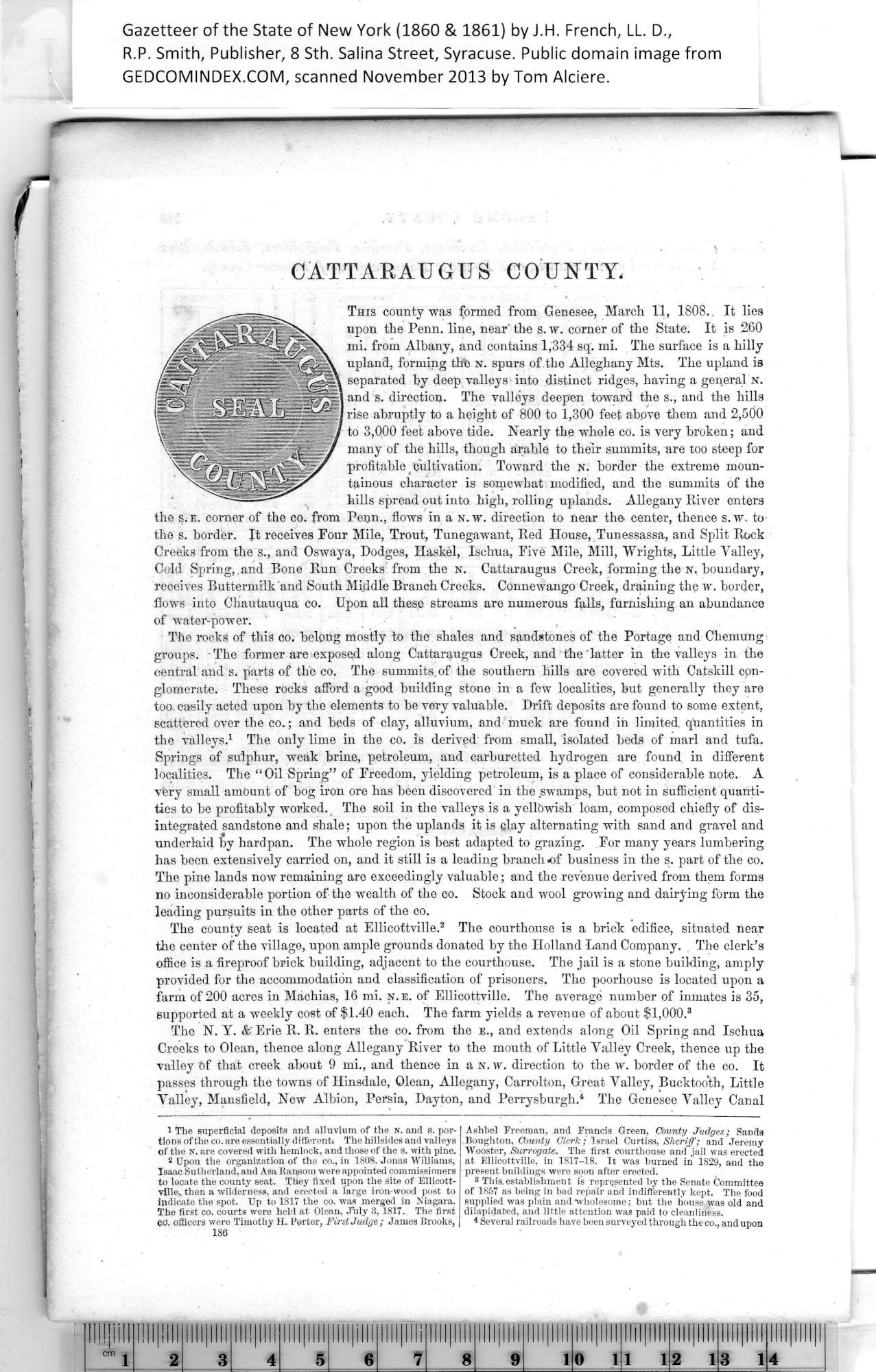|
CATTARAUGUS COUNTY.
This county was formed from Genesee, March 11, 1808.. It lies
upon the Penn, line, near' the s. w. corner of the State. It is 260
mi. from Albany, and contains 1,334 sq. mi. The surface is a hilly
upland, forming the n. spurs of the Alleghany Mts. The upland is
separated by deep valleys into distinct ridges, having a general n.
and s. direction. The valleys deepen toward the s., and the hills
f rise abruptly to a height of 800 to 1,300 feet above them and 2,500
to 3,000 feet above tide. Nearly the whole co. is very broken; and
many of the hills, though arable to their summits, are too steep for
profitable cultivation. Toward the n. border the extreme moun¬
tainous character is somewhat modified, and the summits of the
hills spread out into high, rolling uplands. Allegany River enters
the s.e. corner of the co. from Penn., flows in a n.w. direction to near the center, thence s.w, to
the s. border. It receives Four Mile, Trout, Tunegawant, Red House, Tunessassa, and Split Rock
Creeks from the s., and Oswaya, Dodges, Haskel, Ischua, Five Mile, Mill, Wrights, Little Yalley,
Cold Spring,. and Bone Run Creeks from the N. Cattaraugus Creek, forming the n. boundary,
receives Buttermilk and South Middle Branch Creeks. Connewango Creek, draining the w. border,
flows into Chautauqua co. Upon all these streams are numerous falls, furnishing an abundance
of water-power.
The rocks of this co. belong mostly to the shales and sandstones of the Portage and Chemung
groups. The former are exposed along Cattaraugus Creek, and the latter in the valleys in the
central and s. parts of the co. The summits of the southern hills are covered with Catskill con¬
glomerate. These rocks afford a good building stone in a few localities, but generally they are
too easily acted upon by the elements to be very valuable. Drift deposits are found to some extent,
scattered over the co.; and beds of clay, alluvium, and muck are found in limited quantities in
the valleys.1 The only lime in the co. is derived from small, isolated beds of marl and tufa.
Springs of sulphur, weak brine, petroleum, and carburetted hydrogen are found in different
localities. The “ Oil Spring” of Freedom, yielding petroleum, is a place of considerable note. A
very small amount of bog iron ore has been discovered in the swamps, but not in sufficient quanti¬
ties to be profitably worked. The soil in the valleys is a yellowish loam, composed chiefly of dis¬
integrated sandstone and shale; upon the uplands it is clay alternating with sand and gravel and
underlaid by hardpan. The whole region is best adapted to grazing. For many years lumbering
has been extensively carried on, and it still is a leading branch of business in the s. part of the co.
The pine lands now remaining are exceedingly valuable; and the revenue derived from them forms
no inconsiderable portion of the wealth of the co. Stock and wool growing and dairying form the
leading pursuits in the other parts of the co.
The county seat is located at Ellicottville.2 The courthouse is a brick edifice, situated near
the center of the village, upon ample grounds donated by the Holland Land Company. The clerk’s
office is a fireproof brick building, adjacent to the courthouse. The jail is a stone building, amply
provided for the accommodation and classification of prisoners. The poorhouse is located upon a
farm of 200 acres in Machias, 16 mi. n.e. of Ellicottville. The average number of inmates is 35,
supported at a weekly cost of $1.40 each. The farm yields a revenue of about $1,000.3
The N. Y. & Erie R. R. enters the co. from the e., and extends along Oil Spring and Ischua
Creeks to Olean, thence along Allegany River to the mouth of Little Yalley Creek, thence up the
valley of that creek about 9 mi., and thence in a n. w. direction to the w. border of the co. It
passes through the towns of Hinsdale, Olean, Allegany, Carrolton, Great Valley, Bucktooth, Little
Yalley, Mansfield, New Albion, Persia, Dayton, and Perrysburgh.4 The Genesee Yalley Canal
|
Ashbel Freeman, and Francis Green, County Judges; Sands
Boughton, County Cleric; Israel Curtiss, Sheriff; and Jeremy
Wooster, Surrogate. The first courthouse and jail was erected
at Ellicottville, in 1817-18. It was burned in 1829, and the
present buildings were soon after erected.
3 This, establishment is represented by the Senate Committee
of 1857 as being in bad repair and indifferently kept. The food
supplied was plain and wholesome; but the house was old and
dilapidated, and little attention was paid to cleanliness.
4 Several railroads have been surveyed through the co., and upon |
1
The superficial deposits and alluvium of the N. and S. por¬
tions of the co. are essentially different! The hillsides and valleys
of the N. are covered with hemlock, and those of the s. with pine.
2
Upon the organization of the co., in 1808. Jonas Williams,
3
Isaac Sutherland, and Asa Ransom -were appointed commissioners
4
to locate the county seat. They fixed upon the site of Ellicott¬
ville, then a wilderness, and erected a large iron-wood post to
indicate the spot. Up to 1817 the co. was merged in Niagara.
The first co. courts were held at Olean, July 3, 1817. The first
co. officers were Timothy H. Porter, First Judge; James Brooks,
|
